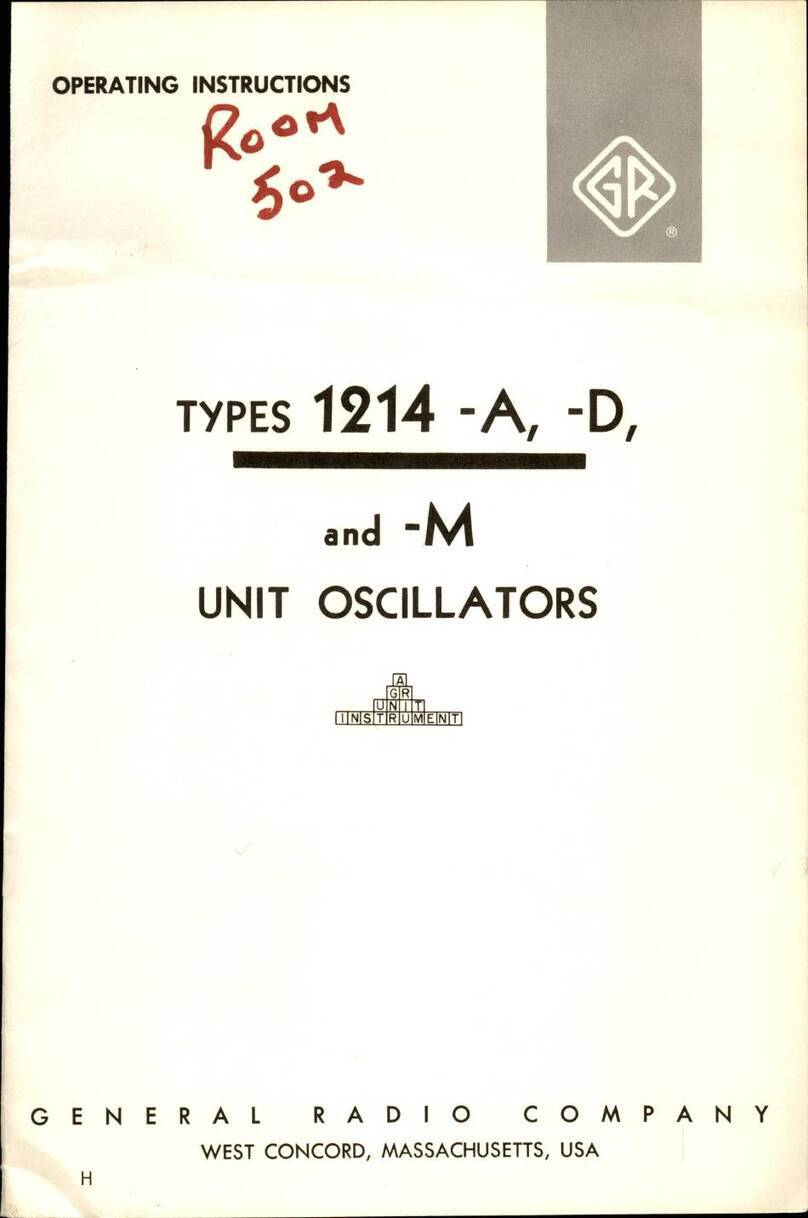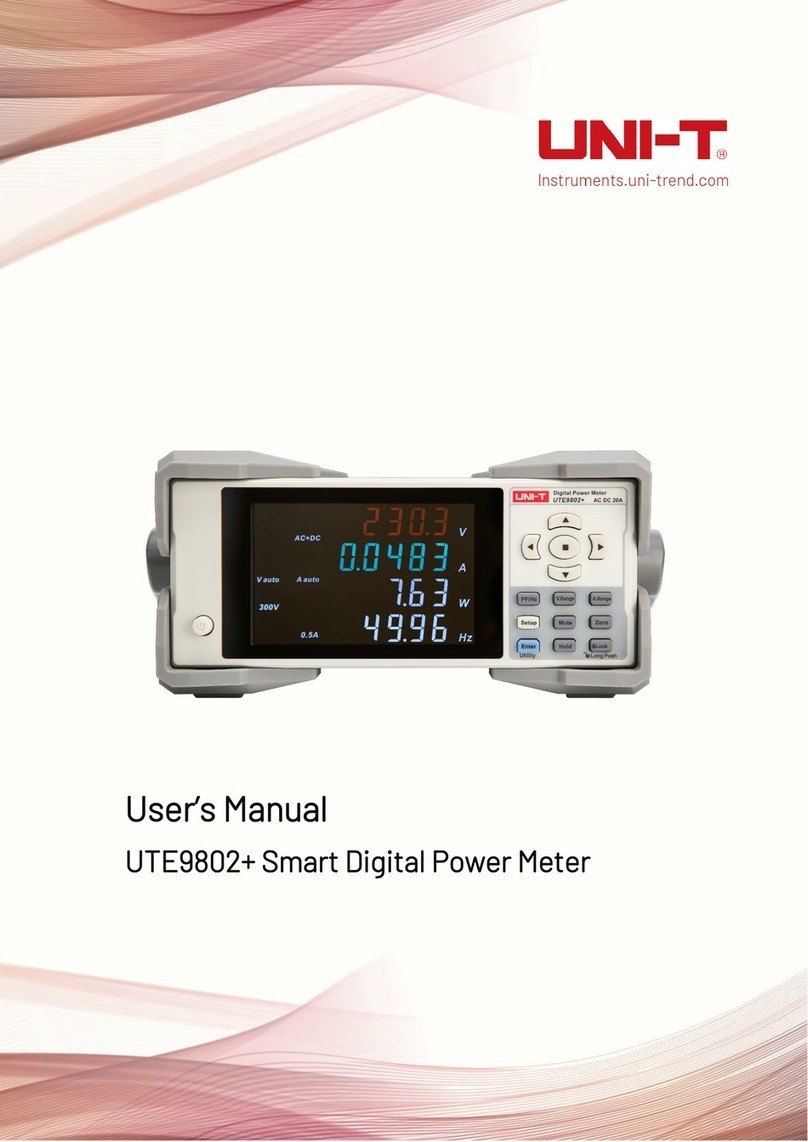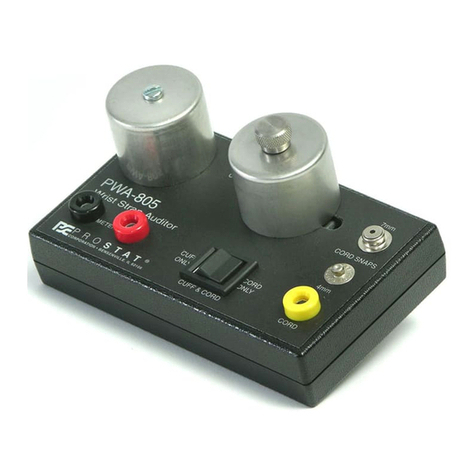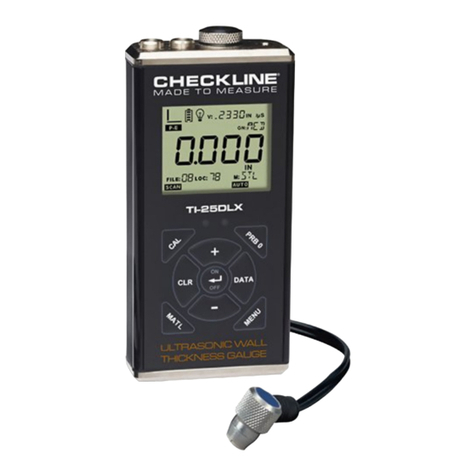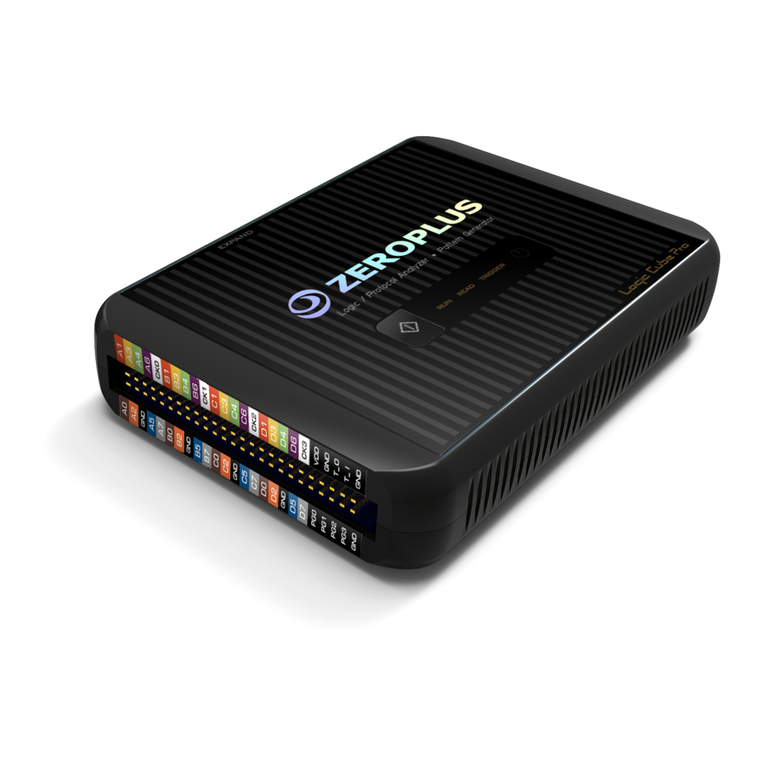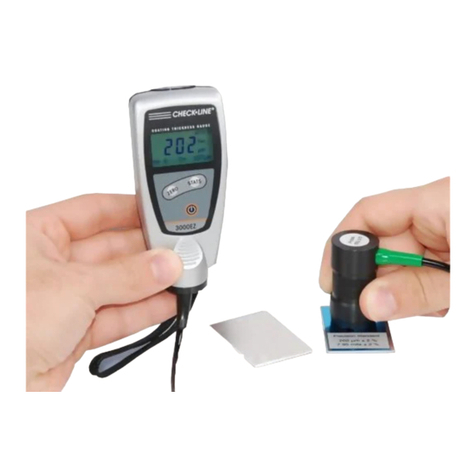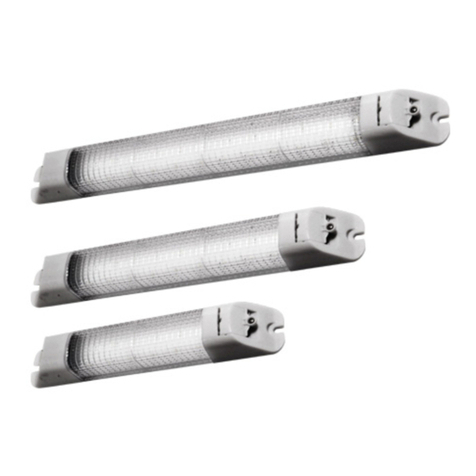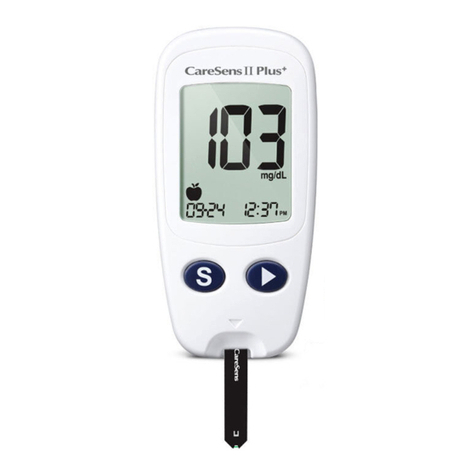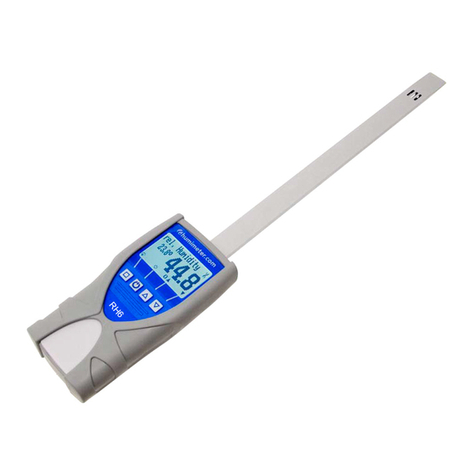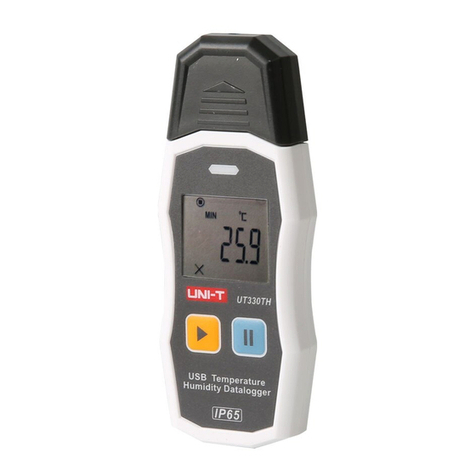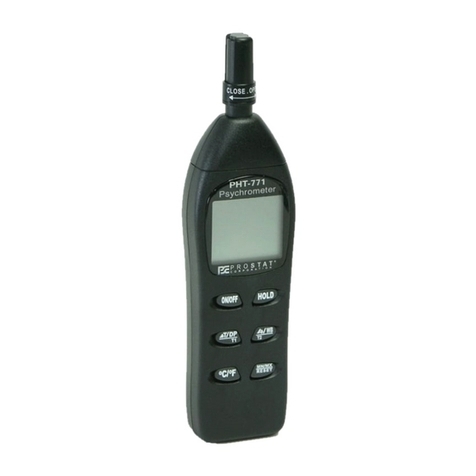GR 1650-A User manual

GENERAL
RADIO
COMPAN'Y
OPERATING INSTRUCTIQ S
TYPE
1650-A
IMPEDANCE
BRIDGE
3005-C
.....

..
Q'PERATING INSTRUCTIONS
TYPE
1650-A
IMPEDANCE
BRIDGE
Form
300S-C
April, 1960
G E N
'E
R A L R A D I 0
COM
PAN
Y
WEST
CONCORD,
MASSACHUSETTS,
USA

TABLE
OF
CONTENTS
Section
1.
INTRODUCTION.
1.1
Description.
1.2
Symbols,
Abbreviations,
and
Definitions
1.3
Series
and
Parallel
Components
•
Section 2. PRINCIPLES OF OPERATION
2.1
General
•
2.2 Bridge
Switching.
•
2.3
Compensation
Techniques
2.4
Bridge
Sources
and
Detectors.
2.5
Orthonull
.
Section
3.
INSTALLATION.
3.1 Opening and
Tilting
the
Cabinet
3.2
Power
Supply . •
Section
4. DC MEASUREMENTS •
4.1
Resistance
Measurements
Using
6-Volt
Supply.
4.2
Resistance
Measurements
Using
External
DC Supplies •
Section
5. OPERATING PROCEDURE 1KC MEASUREMENTS
5.1
Capacitance
Measurement.
•
5.2
Inductance
Measurements
•
5.3
AC
Resistance
Measurement
•
5.4
Notes on
AC
Measurements
•
5.5
Operating
Procedure
with
Orthonull.
Section 6. OPERATING PROCEDURE WITH EXTERNAL
AC
GENERATOR
6.1
Procedure
.
6.2 Connection of
External
Generator
•
6.3
Maximum
AC
Voltage
•
6.4 Allowable D
and
Q
Ranges
vs
Frequency
6.5
Corrections
for
Residual
and
Lead
Impedances.
6.6 Extending
the
D
and
Q
Ranges
at
Low
Frequencies.
•
Section
7. SPECIAL MEASUREMENTS •
7.1
Application
of DC
Bias
to
Capacitors
7.2
Application
of
Direct
Current
in
Inductors
7.3
DC Bias .for
AC
Resistance
Measurements
7.4
Measurement
of
AC
Resistance
with
Reactance.
7.5
Resonant
Frequency
of
Tuned
Circuits.
7.6
Measurements
on Shielded
Three-Terminal
Components.
7.7
Remote
Measurements.
• •
7.8
Measurement
of
Grounded
Components.
7.9
Use
of
the
Type
1650-P1
Test
Jig.
7.10
Limit
Testing.
Section 8. SERVICE
AND
MAINTENANCE •
8.1
General
•
8.2
Battery
Replacement.
• •
8.3
Adjustments
8.4
Trouble-Shooting
Suggestions.
PARTS
LIST.
SCHEMATIC DIAGRAM •
1
1
2
2
3
4
4
5
5
7
7\
7
7
7
8
9
9
10
11
11
12
13
13
13
14
14
14
15
16
16
17
18
18
19
19
19
19
20
20
21
21
21
21
21
24
25

SPECIFICA
liONS
Ranges:-
Resi
stance:
1mD -
10
MD,
8
ranges
ac
or
dc.
Capacitance:
1
f..Lf..Lf
-1000
f..Lf,
7
ranges
se-
ries
on
parallel.
Inductance:
1
f..Lh
-1000
h,
7
ranges
series
on
parallel.
D(of
series
C):
0.001
- 1
at
1
kc.
D(of
parallel
C):
0.1
-50
at
1
kc.
(C
s=Cp
within
1%
if
D<
0.1.)
Q(of
series
L):
0.02
-10
at
1
kc.
Q{of
parallel
L}:
1 -
1000
at
1
kc.
(L
s=Lp
within
1%
if
Q>
10.)
Accuracy:
Resistance:
±1% ±1
mD
(residual
R~l
mD).
(external
dc
supply
required
for
1%
accuracy
a-
bove
100
k.0.)
Capacitance:
±1%
±1
f..Lf..Lf
(residual
C
~
0.5
f..Lf..L
f
).
Inductance:
±1% ±1
f..Lh
(residual
L<
0.2
f..Lh).
it
±5%;
±0.001
at
1
kc
or
lower.
lIQ:
±5%;
±0.001
at
1
kc
or
lower.
Frequency
Range
(1
kc
supplied
internally):
for
1%
accuracy
for
Land
C, 20
cps
to
20
kc;
for R,
U.S.
Patent
No. 2,872,639.
20
cps
to
5
kc.
(D
and
Q
ranges
are
functions
of
frequency.)
Internal
Oscillatar
Frequency
(external
ac
and
dc
sources
can
also
be
used):
1
kc
±2%.
Internal
Detector:
Response,
flat
or
selective
at
1
kc;
sensitivity
control
provided.
Internal
DC
Supply:
6
v,
60
rna max.
Power
Supply:
4 D
cells,
supplied.
Current
drain
for
ac
measurements,
10
rna.
DC
Polari
zation:
600
vmay
be
applied
(from
ex-
ternal
source)
to
series
capacitance
measure-
ments.
Accessories
Supplied:
One
Type
274-MB
Double
Plug.
Other
Accessories
Available:
Type
1650-P1
Test
Jig.
Other
Accessories
Required:
None.
Earphones
may
be
used
for
high
precision
at
extremes
of
bridge
ranges.
Mounting: Aluminum
cabinet,
with
captive
cover.
Dimensions:
Height
12-3/4
in.,
width
12-1/2
in.,
depth
7-3/4
in.,
including
handle.
Weight: 17
lb.
General
Radio
Experimenter
reference:
Volume
33,
No.3,
March 1959;
"Orthonull",
Volume
33,
No.4,
April 1959.
SPECIAL REQUEST
TO
THE
USER
OF
TillS
INSTRUMENT
We
believe
that
the
most
effective
way
to
make
our
products
more
useful
is
to
learn
from
the
experience
and
opinions
of
those
who
use
them.
For
this
reason
we
have
included
a
questionnaire
at
the
rear
of
this
manual.
Your
answers
to
the
questions
contained,
based
on
your
experi-
ence
in
using
this
instrument,
will
be of
great
value
to
General
Radio
engineers
and
other
personnel
concerned
with
new
products.
Such
com-
ments
will
have
a
strong
influence
on
the
direction
of
future
development
work.
The
resulting
better
products
will
benefit
our
customers
as
well
as
ourselves.
The
questionnaire
sheet
is
its
own
postage-paid
envelope.
Simply
cut
it
out, fold
as
directed,
staple,
and
mail.
Any
information
you
supply
will
not
go
outside
our
company
without
your
specific
advance
authorization.
May
we
have
your
opinions?

Figure
1.
Type
1650-A
Impedance
Bridge.

TYPE
1650-A
IMPEDANCE
BRID'GE
Section 1
INTRODUCTION
1.1 DESCRIP'IlON.
1.1.1 GENERAL.
The
Type
1650-A
Impedance
Bridge
(Figure
1)
is
a
self-contained
impedance-
measuring
system,
which
includes
five
bridges
for
the
measurement
of
capacitance,
resistance,
and
in-
ductance'
as
well
as
the
generators
and
detectors
necessary
for
dc
and
1-kc
ac
measurements.
Fea-
tures
of
this
bridge
include
one-percent
C,
R,
and
L
accuracy
over
all
ranges,
high
0
and
Qaccuracy,
a
mechanism
to
facilitate
low Q
measurement,
vis-
ual
ac
and
dc
null
indications,
complete
portability,
and
a
convenient
tilting
mechanism
and
carrying
case.
1.1.2
CONTROLS.
The
Table
of
Contro!sgiven
be-
low
lists
the
controls
located
on
the
front
panel
of
the
Type
165O-A
Impedance
Bridge.
1.1.3
CONNECTORS.
The
Table
of
Connectors
given
below
lists
the
connectors
located
on
the
front
panel
of
the
Type
1650-A
Impedance
Bridge.
TABLE OF CONTROLS
Name No.
Type
Function
CRL
MULTIPLIER
Sl
8
-po~ition
selector
switch
Selects
impedance
range.
CRL
SELECTOR
S2
5-position
selector
switch
Selects
bridge
circuit.
•
FUNCTION Switch S3
5-position
selector
switch
Turns
bridge
on
to
type of
operation
required.
CRL
Dial
Rl
Continuous
rotary
control
Adjusts
for
bridge
balance.
DQ
Dial
R2 Continuous
rotary
control
Adjusts
for
bridge
balance.
ORTHONULL
Lever
Mechanical
lever
Engages
Orthonull
mechanism.
DETECTOR
Switch S4
Toggle
switch
Controls
detector
response.
OSC
LEVEL
R18
Thumbset
rotary
control
Controls
ac
oscillator
level.
SENSITIVITY R15 Continuous
rotary
control
Controls
ac
and
dc
detector
R16
sensitivity.
TABLE OF CONNECTORS
Name
No.
Type
Function
UNKNOWN
]7,
J8
Jack
-top binding
-post
pair
Com.ects
unknown
impedance
EXT
GEN
Jl,
J2
Jack
-top
binding
-post
pair
Connects
ac
or
dc
external
source
BIAS
J3, J4 Jack
-top
binding-post
pair
Connects
dc
bias
DET
OUTPUT J5, J6
Jack-top
binding-post
pair
Connects
external
amplifier
or
phones

Q2 LpLp
1+Q2 1+D2
1+Q2 Ls
(l
+D2) Ls
Q2
lcs
Ls
Rp
l'
cp
Rp
Lp
R
s
Resistance
and
Inductance
Q
__
1_
=
wL
s
=~
D Rs
wL
p
Figure
2.
Equivalent
Circuits
for
Complex
Impedance.
are:
bination
is
used.
The
equivalent
circuits
are
shown
in
Figure
2.
The
relationships
between
the
circuit
elements
1
(l
+Q2) Rs
Rs1+Q2 Rp;Rp
wL
s
Rs
=--.
Rp=
QWL
p
Q,
Resistance
and
Capacitance
RD1
02R
+--
I
jCcC
pp .
CcC
JP
ZRs
+~
-
JW
s11+02
R
+--
P
'CcC
J P
11
0
=-
wRsC
s=
QWRpCp
Cs
(l
+D2) Cp;CpCs
+02
021+D2
Rs1+D2 Rp; RpD2 Rs
D1
Rs
=--'
Rp
wC
s,
CcCpD
2
1
=Q
1
1
=~
=c1p
parallel
inductance
resistance
~),
the
real
part
of
an
impedance
series
resistance
series
capacitance
parallel
capacitance
inductance
(~)
series
inductance
parallel
resistance
reactance,
the
imaginary
part
of
an
impedance
impedance
quality
factor
=+
wL
s
for
inductors
~
d· . . fR
IsslpatiOn
actor
=
X-
for
capacitors
wcsR
s=
wCpI),
R R
power
factor
=-c
-;:=:;:==::;-
Izl
\lR2
+X2
GENERAL RADIO COMPANY
Lp
R
Rs
Rp
X
z
Q
1.2
SYMBOLS, ABBREVIATIONS, AND
DEFINITIONS.
The
following
symbols,
abbreviations,
and
defini-
tions
are
used
on
the
panel
of
the
Type
1650-A
and
this
instruction
manual:
C
capacitance'
(-n---)
f
frequency
w
angular
frequency
2m
Q
ohm,
a
unit
of
resistance,
reactance,
or
impedance
kQ
kilohm
1kQ =1000
ohms
M
multiplying
factor
applied
to
0
and
Q
at
frequencies
other
than
1
kc
MQ
megohm
1MQ =1 x
10
6
ohms
mQ
milliohm
1
mQ
=0.001
ohm
flf
microfarad,
a
unit
of
capacitance
mfli
millimicrofarad
1mfli =0.001 fli
flfli
micromicrofarad
1flfli =1 x
10-
6fli
h
henry,
a
unit
of
inductance
mh
millihenry
1
mh
=
o.(Xn
h
flh
microhenry
1
flh
=1 x
10-
6h
1.3
SERIES
AND
PARALLEL
COMPONENTS. An
impedance
that
is
neither
a
pure
reactance
or
a
pure
resistance
may
be
represented
at
any
specific
frequency
by
either
a
series
or
a
parallel
combina-
tion
of
resistance
and
reactance.
The
values
of
re-
sistance
and
reactance
used
in
the
equivalent
cir-
cuit
depend
on
whether
a
series
or
a
parallel
com-
Cs
Cp -
L
Ls
o
PF

TYPE
16S0-A
IMPEDANCE
BRIDGE
Section 2
PRINCIPLES
OF OPERATION
2.1 GENERAL.
Figure
3
shows
the
five
bridge
cir-
cuits
used
in
the
Type
1650-A
Impedance
Bridge,
as
well
as
the
balance
equations.
Hays
and
Maxwell
inductance
bridges
and
series
and
parallel
capaci-
tance
comparison
bridges
are
used
to
provide
wide
coverage
over
the
D
and
Q
ranges,
as
shown
in
Fig-
ure
4.
Full
use
of
these
wide
ranges
at
low Q
and
high D
values
is
achieved
by
means
of
an
Orthonull
balancing
mechanism
(refer
to
paragraph
2.5). Both
ac
and
dc
measurements
may
be
made
with
the
bridge,
which
has
no
internal
phase
balance.
The
variable
bridge
components
are
General
Radio
precision
wire-wound
rheostats.
The
CRL
rheostat
uses
a
mechanical
justifying
mechanism
for
high
accuracy,
and
the
DQ
rheostat
has
a
54-db
logarithmic
range.
The
standard
capacitor
is
a
General
Radio
Type
505
s~lvered-mica
capacitor,
Cs
(LOW
0)
o
TO
I
SERIES
CAPACITANCE
C=RNC
XRAr
Ox
=fIIR
xCx=
fIIRrC
r
Cp
(
HIGH
0)
01 TO
50
PARALLEL
CAPACITANCE
Cx
RN
Cx=RACT
I I
Ox
=fIIRx
C~
=fIIRrCr
R
(A.C.)
O.C.
REStSTANCE
LS
(
LOW
0 )
.02
TO
I
SERIES
INOUCTANCE
Lx
Lp
(
HIGH
0)
0./-
00
PARALLEL
INOUCTANCE
Lx=R
N1Cr
0=
i
=_,-
fIILx
fIIRrC
r
Figure
3.
Bridge
Circuits
Used in Impedance
Bridge.
3

GEN~AL
RADIO
COMPANY
EXT
GEN
~
INT
AC
EXT
DC·
BIAS
OFF
IN
OFF
POSITION
BATTERY
DISCONNECTED
EXT
GEN
DISCONNECTED
METER
SHUNTED
OSC
LEVEL
LJ
INT
DC
EXT
AC
BIAS
E1
GEN
~
150,Q
D=I
Q=I
Cp
LS
(MAXWELL)
Lp
(HAY)
Q=IO
Figure
4.
DQ
Coverage
Chart.
and the
resistors
are
General
Radio
wire-wound
cards
except
for
the
I-megohm
ratio
arm,
which
uses
a
1/4%
precision
film
resistor.
2.2
BRIDGE SWITCHING.
The
CRL
MULTIPLIER
switch
(SI)
selects
the
bridge
range
by
switching
in
various
ratio
-arm
resistors.
Clockwise
rotation
of
this
two
-rotor
.switch
increases
the
multiplier
value
for
the
R,
L,
and C
bridges.
Both
ends
of
the
range
resistor
are
switched
out
so
that
the
unused
resis-
tors
may
be
grounded
to
reduce
capacitance
across
this
arm.
Double,
solid
silver
contacts
insure
low
switch
resistance
and
long
switch
life.
Figure
5.
Source
and
Detector
Diagrams.
several
compensating
schemes
are
used.
The
com-
ponents
used
for
this
purpose
are
listed
below, with
brief
description
of
their
functions.
SENS
SENS
C2 and
LI:
These
components
are
used
to
make
the
standard
resistance
arm
(Rb,
Figure
3)
appear
resistive
over
awide
frequency
range.
This
arm
is
shunted
with
considerable
stray
capacitance,
which,
without
compensation,
would
cause
a
poor
ac
null
2.3
COMPENSATION TECHNIQUES.
To
achieve
the
required
D-Q
accuracy
over
such
wide
ranges,
The
CRL
SELECTOR
switch
(S2)
switches
the
bridge
circuits.
The
actions
of
this
switch
are
such
that
it
(1)
selects
the
correct
rotors
of SI and
grounds
one
of
the
unused
rotors,
(2)
selects
the
correct
standat'd
arm,
and
(3)
reverses
the
bottom
two
arms
of
the
bridge
to
form
the
Land
R
or
C
bridges.
The
function
switch
(see
Figure
5)
sets
up
the
correct
internal
source
and
detector
circuits
for
the
desired
operation.
When
this
switch
is
in
either
of
the two
EXT
positions,
the
EXT
GEN
terminals,
used
for
externally
applied
ac
or
dc,
are
connected
in
as
the
bridge
source.

TYPE
16S0-A
IMPEDANCE
BRIDGE
and
an
error.
The
resistances
of
LI
and
R4
add
up
to
the
reqUired
10
kilohms.
C3:
This
capacitor
corrects
the
phase
angle
of
the
first
section
of
the
DQ
potentiometer
(Rt)
to
compensate
for
the
inductance
of
the
winding.
With-
out
compensation,
this
inductance
would
cause
an
error
in
Cs
and
Lp
at
high
frequencies,
and
in
Cp
and
Ls
when
the
Unknown
has
a
very
low Q
or
high
D.
C4:
This
capacitor
corrects
for
the
phase
shift
caused
by
stray
capacitance
across
the
CRL
rheo-
stat
(RN).
This
capacitor
forms
a
three-terminal
T
network
with
the
two
parts
of
the
rheostat
to
pro-
duce
an
effective
inductance
to
balance
out
the
stray
capacitance.
C5:
This
capacitor
compensates
for
the
stray
capacitance
across
the
I-megohm
ratio
arm
(R12
and
R13).
The
three-terminal
T
network
formed
by
these
components
produces
an
effective
inductance
to
balance
out
the
stray
capacitance.
C6:
This
capacitor
compensates
for
the
induct-
ance
of
the
I-ohm
ratio
arm
(R5).
2.4
BRIDGE SOURCES
AND
DETECTORS.
The
dc
bridge
supply
is
taken
from
the
four
internal
D
cells,
which
supply
about
6
volts
limited
by
a
100-
ohm
resistor
to a
maximum
of 60 mao
The
dc
in-
dicator
on
the
panel
has
a
sensitivity
of'
2\la/mm
near
zero,
a
resistance
of 75
ohms,
and
a
shaped
characteristic
(Marion
Type
C
null
indicator)..
The
ac
source
is
a
I-kc
transistor
LC
oscil-
lator,
which
uses
the
primary
of
the
bridge
trans-
former
as
the
inductor
in
the
tuned
circuit.
The
output
voltage
is
about
1
volt
at
the
secondary
of
the
4-to-I
step-down
transformer.
This
secondary
is
wound
with
resistance
wire
to
increase
the
re-
sistance
to
about
ISO
ohms,
preventing
external
loads
from
affecting
the
bridge
frequency.
The
OSC
LEVEL
contfol
adjusts
output
voltage
by
loading
the
trans-
former
secondary.
The
ac
detector
is
a
three-transistor,
vari-
able-gain
amplifier,
which
uses
a
twin-T
RC
filter
to
obtain
selectivity
with
the
DETECTOR
switch
in
the
1
kc
position.
This
amplifier
drives
the
panel
meter
to
provide
a
visual
ac
null
indication,
and
the
output
from
the
amplifier
is
supplied
to
the
panel
DET
OUTPUT
terminals.
The
ac
oscillator
and
detector
combined
draw
less
than
10
rna
from
the
internal
6-volt
battery.
2.5
ORTHONULL.
Orthonull
is
a
mechanical
device
that
improves
the
bridge
balance
convergence
when
low Q
inductors
or
high D
capacitors
are
measured.
5
Ordinarily,
balances
with
such
components
are
tedi-
0us
and
often
impossible
due
to
the
"sliding
null"
resulting
from
the
interdependence
of
the
two
ad-
justments.
Rapid
balances
are
possible
with
Ortho-
null,
which
does
not
affect
electrical
balance
but
which
does
help
avoid
false
nulls,
improving
bridge
accuracy
for
low Q
measurements.
The
bridge
output
voltage
for
the
Ls(Maxwell)
bridge
can
be
expres
sed:
(1)
Denominator
We
will
assume
that
the
denominator
is
more
or
less
constant
in
the
region
of
the
null.
The
numer-
ator
is
the
difference
between
the
unknown
imped-
ance
Rx+jWLx
and
what
can
be
called
the
"bridge
impedance".
The
bridge
output
is
proportional
to
this
difference,
which
is
the
distance
between
them
on
the
complex
plane.
To
balance
the
bridge,
the
"bridge
impedance"
is
varied
by
adjustment
of
Rn
(the
CRL
dial)
and
Rt
(the
DQ
dial)
until
it
equals
the
unknown
impedance.
An
adjustment
of
Rr
varies
only
the
real
part
of the
bridge
impedance,
whereas
an
adjustment
of
Rn
varies
both
parts,
and
is
there-
fore
a
multiplier
of
the
bridge
impedance.
Thus,
adjustment
of
Rt
moves
the
bridge
impedance
hori-
zontally
on
the
complex
plane,
while
adjustment
of
Rn
moves
it
radially
(see
Figure
6).
Each
control
is
adjusted
for
a
minimum
voltage.
RNVARIED
-===--------
__ R
Figure
6.
Loci
of
Rn
and
Rt
Adjustments
on
Z
Plane.
When
X»R
(i.e.
when Q
is
high)
these
two
ad-
justments
are
almost
orthogonal,
and
rapid
con-
vergence
is
possible.
When Q
is
low,
however,
the
adjustment
becomes
more
parallel
and
convergence
is
slow,
causing
a
"sliding
null",
as
shown
in
Fig-
ure
7,
where
Q=
1/2.
With
smaller
Q'
s,
conver-
gence
is
even
slower.
The
Orthonull
device
makes
the
two
adjust-
ments
orthogonal
by
nonreciprocally
ganging
Rn
and
Rt.
From
equation
(1)
it
is
apparent
that
if
Rn/Rt
remained
constant
as
Rn
was
varied,
only
the
imaginary
part
of
the
bridge
impedance
would

GENERAL
RADIO
COMPANY
•
D-tOO
00.01
0"0
Q-O.l
WITH
ORTHONULL
01
001
Figure
9.
Accuracy
vs
D
or
Q.
-FALSE
NULL·
CAUSED BY
Rg'g~U~ON
\
"'-..,...\
°2);----;-----;------!-------:':----!:---'
z
I
>-
~
25
>-
w
'"
o
>-
",20
>-
z
w
::<
>-
~
15
o
..
u.
o10
Q:
w
'"
::<
:::>
z
...J
..
b
>-
/
/
V
%
.
10
Q
Figure
8.
Number
of
Balances
vs
Q.
tually
impossible
to
achieve
1%
balances.
The
ac-
curacy
that
can
be
expected
with
careful
adjustment
is
plotted
against
Q
in
Figure
9.
In
the
face
of
the
fact
that
for
low Q
values
dl zl =2
dL
/ZT
Q
--r=--
the
eventual
lack
of
accuracy
is
justified.
For
ex-
ample,
if
Q=
0.03,
a
5%
change
in
inductance
is
a
change
of only 45
parts
per
million
in
impedance.
As
far
as
the
user
is
concerned,
the
balanc-
ing
procedure
with
Orthonull
is
essentially
the
same
as
without
it.
However,
several
suggestions
for
its
use
are
given
in
paragraph
5.5.
6
x
Figure
7. Loci
of
"Sliding
Null"
Balance.
The
Orthonull
mechanism
is
shown
in
Figure
21.
The
clutch
material
is
between
the
pulley
at-
tached
to
the
DQ
shaft
and
the
free
pulley
driven
by
the
wire
belt.
The
clutch
is
disengaged
by
the
lever
on
the
panel
so
that
normal
operation
is
·possible
for
high
Q(low
D)
components.
The
advantage
of
Orthonull
is
illustrated
in
Figure
8,
which
is
a
plot
of
the
numbers
of
adjust-
ments
necessary
for
a
balance.
Not only
does
the
Orthonull
reduce
the
number
of
balances,
but
it
per-
mits
1%
measurements
that
would
otherwise
be
im-
possible
below
a Q
of
1/3,
due
to
the
finite
resolu-
tion
of
the
DQ
rheostat.
This
finite
resolution
causes
the
meter
indication
to
vary
in
jumps
when
Ortho-
null
is
used
at
Q's
below
1/3.
However,
by
choos-
ing
the
best
null,
1%
accuracy
is
possible
with
Q's
of
less
than
0.2.
As
Qis
further
reduced,
it
is
even-
The
ratio
RuIRt
must
be
constant
for
varia-
tion
in
Rn
for
any
initial
settings
of Rn
and
Rt,
since
Rr
may
be
moved
independently
of
Ru.
This
requires
rheostats
with
exponential
characteristics
(and
logarithmic
dials).
The
DQ
rheostat
is
a
54-
db
exponential
potentiometer
with
the
correct
initial
resistance
(R3)
added
when
the
Ls
and
Cp
bridges
are
used.
The
CRL
rheostat
is
exponential
in
the
dial
range
from
1
to
11,
and
linear
pelow
1.
Thus,
for
correct
Orthonull
action,
the
CRL
dial
must
be
in
the
range
above
1.
change.
But
when
Rt
is
adjusted,
Ru
must
not
move
to
vary
only
the
real
part.
The
solution
is
a
simple
friction
clutch
to
permit
nonreciprocal
action.
Both
the
inherent
difference
in
friction
of
the
two
rheo-
stats
and
the
pulley
ratio
favor
torque
transmission
in
the
desired
direction.

TYPE
1650-A
IMPEDANCE
BRIDGE
Section 3
INST
ALLA
TIO·N
3.1 OPENING
AND
TILTING
THE
CABINET.
The
directions
for
opening
the
Type
1650-A
Impedance
Bridge
are
given
on
the
handle
support
of
the
instru-
ment.
Once
open,
the
instrument
may
be
tilted
to
any
convenient
angle
as
shown
in
Figure
1.
The
an-
g1e
should
be
chosen
to
give
the
most
comfortable
access
to
the
knobs
and
the
best
view
of the
meter
and
dials.
The
instrument
may
be
locked
fully
open
by
the
same
slide
pins
that
are
used
to
lock
the
instru-
ment
closed.
Thus,
the
instrument
CaR
be
carried
in
the
open
position
with
the
cover
firmly
in
place.
When
the
instrument
is
Opel1,
the
cover
forms
a
convenient
storage
place
for
the
instruction
man-
ual
and
for
any
other
test
data
that
should
be
kept
with
the
instrument.
3.2 POWER SUPPLY.
The
instrument
is
powered
by
four
D
cells,
which
slide
into
the
instrument
through
the
cap
at
the
top.
These
batteries,
sup-
plied
with
the
instrument,
should
be
installed
with
the
positive
terminals
(center
buttons)
facing
down.
The
instrument
is
ready
to
operate
as
soon
as
it
is
in
position
and
turned
on.
Section 4
OPERATING
PROCEDURE
4.1 RESISTANCE MEASUREMENTS
USING6-VOLT
SUPPLY.
4.1.1 PROCEDURE.
a.
Check
the
NULL
meter
mechanical
zero
with
the
function
switch
in
the
OFF
position,
and.
if
necessary,
center
the
pointer
with
the
mechani-
cal
zero
adjustment
on
the
meter.
b.
Turn
the
SENSITIVITY
control
almost
fully
counterclockwise.
c.
Set
the
CRL
SELECTOR
to
R.
d.
Connect
the
resistor
to
be
measured
to
the
UNKNOWN
terminals.
e.
Turn
the
function
switch
to
INT
6V.
NOTE
As
the
function
switchis
rotated
from
OFF
to
INT
6
V,
it
passes
through
an
undetented
position
where
the
circuit
is
operative
but
the
meter
is
shunted
to
reduce
sensitivity.
A
preliminary
balance
may
be
made
with
the
switch
in
this
position
instead
of
with
the
SENSITIVITY
control
turned
down.
DC
MEASUREMENTS
f.
Set
the
CRL
MULTIPLIER
switch
and
the
CRL
dial
for
a
zero
(center)
meter
reading,
while
adjusting
the
SENSITIVITY
control
to
increase
sen-
sitivity.
A
meter
deflection
to
the
right
indicates
that
the
unknown
is
larger
than
the
multiplier
and
dial
setting.
For
greatest
accuracy
the
final
balance
should
be
between
1
and
11
on
the
CRL
dial
(pos-
sible
above 100
milliohms).
g.
The
value
of
the
unknown
resistance
is'
the
product
of
the
CRL
dial
indication
and
the
factor
in-
dicated
on
the
CRL
MULTIPLIER
switch.
4.1.2
SENSITIVITY. With
the
internal
6-volt
sup-
ply,
one-percent
balances
may
be
easily
made
up
to
10
kilohms
and
with
care
up
to
100
kilohms.
Above
100
kilohms
a
higher
external
voltage
should
be
used
(refer
to
paragraph
4.2).
A
100-ohm
resistor
in
series
with
the
internal
6-volt
supply
limits
the
current
in
the
unknown
to
60
rna.
The
unknown
is
in
series
with
the
CRL
rlreostat,
so
that
the
unknown
current
is
greatest
when
the
C-ItL
dial
is
at
zero.
The
maximum
power
that
can
be
applied
to
the
bridge
by
the
internal
supply
is
0.09
watt;
thus
there
is
no
danger
of
injuring
components
rated
at
.
1/10
watt
or
more.
L
7
)

GENERAL
RADIO
COMPANY
At
range
extremes
it
is
often
desirable
to
make
I-kc
ac
measurements
to
increase
sensitivity.
Formost
resistors,
the
difference
between
the
meas-
ured
I-ke
and de
values
is
negligible.
4.1.3 ACCURACY OF DC RESISTANCE MEAS-
UREMENTS.
The
accuracy
of
dc
resistance
tneas-
urements
is
±I
%
if
the
CRL
dial
reading
is
between
1and
11
as
long
as
there
is
enough
sensitivity.
Be-
low 100
milliohms,
balance
must
be
made
with
the
CRL
dial
set
below
1,
and
the
bridge
accuracy
is
±I
milliohm
if
the
1-milliohm
zero
resistance
of
the
bridge
is
subtracted
from
the
reading.
For
low
-
resistance
measurements,
short,
heavy
leads
should
be
used
as
connections
to
the
unknown.
The
zero
resistance
of
the
leads
should
be
measured
with
the
free
ends
connected
together,
and
subtracted
from
the
bridge
reading
with
the
unknown
in
pJace.
The
user
should
be
particularly
careful
when
using
banana
-
pin
connections.
For
best
connection
to
the
bridge,
screw
the
binding
post
hard
enough
to
notch
the
wire
inserted
in
the
hole.
4.2 RESISTANCE MEASUREMENTSUSING
EXTER-
NAL DC SUPPLIES.
4.2.1 PROCEDURE.
The
procedure
for
dc
resist-
ance
measurements
using
an
external
supply
is
the
same
as
that
described
in
paragraph
4.1.1
except
that:
a.
The
external
supply
should
be
connected
a-
cross
the
EXT
GEN
terminals.
b.
Set
the
function
switch
to
the
DC
EXT
posi-
tion.
WARNING
When
using
external
dc
supplies
be
careful
that
there
is
no
danger
to
the
TABLE I
MAXIMUM DC BRIDGE VOLTAGE
AND
CURRENT
operator.
It
is
advisable
to
limit
high
-voltage
supplies
to
a
current
of
5rna
or
less
by
placing
resistance
in
series.
Care
should
also
be
taken
to
avoid
damage
to
the
bridge
and
to
the
unknown
component.
4.2.2
VOLTAGE
AND
CURRENT LIMITS.
Bridge
voltages
must
be
limited
to
protect
the
bridge
and
the
unknown
component
from
damage.
It
is
also
ad·
visable
to
limit
the
current
to
5rna
or
less
to
pro-
tect
the
operator
from
injury.
The
maximum
volt-
age
limit
and
standard
EIA
test
voltages
are
de-
scribed
below.
Unless
the
utmost
in
sensitivity
or
a
standard
test
voltage
is
desired,
a
supply
of
about
100
volts
(e.g.
a
90-volt
battery),
with
about
25
ldlohms
in
series,
is
recommended.
The
available
power
from
such
a
supply
is
0.1
watt,
which
is
low enough
dis-
sipation
for
almost
all
resistors,
and
the
maximum
current
is
4
rna.
Such a
supply
permits
measure-
ments
up
to
1
megohm
with
1%
accuracy.
For
re-
sistances
over
1
megohm
a
higher
voltage
is
de-
sirable
for
good
sensitivity,
but
it
should
be
noted
that
the
maximum
EIA
test
voltage
is
100volts,
and
that
various
types
of
resistors
have
different
volt-
age
ratings.
The
maximum
voltage
and
current
that
may
be
applied
to
the
bridge
for
each
range
are
given
in
Table
1.
Careful
observation
of
both
of
these
lim-
its
will
prevent
damage
to
the
bridge.
Because
the
full
voltage
may
be
applied
to
the
unknown,
it
is
advisable
to
limit
the
available
power
to
a
value
less
than
the
power
rating
of
the
unknown
component.
Various
EIA
standards
for
testing
different
types
of
resistors
are
summarized
in
Tables
2
and
TABLE 2
EIA STANDARD
TEST
VOLTAGES
(RS 172 -FIXED COMPOSmON RESISTORS)
•
•••
Range Range EMax
I·
Max
Full
Scale
Multiplier
1 n
lOOrnn
71
v100 rna
lOn
1 n
71
v100 rna
100 n10 n
71
v
71
rna
1
kn
100 n
71
v
22
rna
10
kn
1
kn
71
v14.1 rna
100
kn
10
kn
223 v14.1 rna
1
Mn
100
kn
500 v14.1 rna
10
Mn
1
Mn
500 v14.1 rna
•It
is
preferable
to
limit
current
to avoid
shock
hazard
or
to
reduce
voltage
to
10
v.
Resistance
Range Bridge Mult Range EIA
Test
Bridge·
Voltage
Range
Voltage
2.7 -99 n1 n
0.5
- 1 v
••
10 n
0.5
- 1 v 50 -
71
v···
100 -999 n
lOon
2.5
- 3 v
27.5
-
33
v
1000 -9999 n1
kn
8
-lOv
16
-20v
10 -99
kn
10
kn
24 -30 v26.4 -
33
v
100
kn
up 100
kn
80 -100 v80 -100 v
1
Mn
80 -100 v80 -100 v
at
EXT GEN
terminals
••
cannot
get
reqUired
bridge
voltage
limited
to
71
vby
bridge
8

TYPE
1650-A
IMPEDANCE
BRIDGE
3. A
suggested
setup
for
tests
at
these
voltages
is
shown
in
Figure
10.
The
voltmeter
here
indicates
the
bridge
voltage,
and
should
be
set
as
listed
in
Tables
2
and
3. An
alternate
scheme
is
to
put
the
voltmeter
directly
across
the
unknown
resistor,
as-
suming
that
the
input
resistance
of
the
voltmeter
is
large
enough
to
cause
no
error.
CURRENT-LIMITING
RESISTOR '
BRIDGE
V
VOLTAGE
Figure
10.
Circuit
for
Tests
at
EIA
Voltages.
Section
OPERATING PROCEDURE
TABLE 3
EIA STANDARD
TEST
VOLTAGES
(RS 196
FIXED
FILM
RESISTORS
REC
117 LOW-POWER WIRE-WOUND RESISTORS)
Resistance
Bridge
Mult
EIA
Max
Max
Bridg
Range Range
Test
Voltage
Voltage*
less
than
10 0 1 0
0.3
v
**
10 -99 010 0 1 v
**
lQO -999 0
1000
3v
33 v
1000 -9999 0 1 kO
lOv
20v
10 -99
kO
10 kO 30 v33 v
100 kO up 100 kO 100 v101 v
1
MO
100 v100 v
REC 117
applie
sonly up to 9999
D.
*
At
EXT
GEN
terminals.
** Maximum
allowable
bridge
voltage
will not
give
maximum
test
voltage.
5
l-KC
MEASUREMENTS
5.1 CAPACITANCE MEASUREMENT.
5.1.1 PROCEDURE.
a.
Set
OSC
LEVEL
control
fullyon
(clockwise).
b.
Set
DETECTOR
switch
to
1
kc.
c.
Set
CRL
Selector
to
Cs-
if
series
capacitance
is
desired
and
D
is
less
than
1.
Cp-
if
parallel
capacitance
is
desired
and
D
is
between
0.1
and
SO.
(Note: Cs=Cp
within
1%
if
D(
0.1.)
d.
Set
the
function
switch
to
INT
1KC.
e.
Connect
the
unknown
capacitor
to
the
UN-
KNOWN
terminals.
f.
If
the
proper
range
setting
of
the
CRL
MUL-
TIpLIER
is
not
known,
set
the
CRL
dial
at
about
midscale,
adjust
the
SENSITIVITY
control
adjusted
to
give
an
upscale
meter
reading,
and
set
the
CRL
MUL
TIPLIER
switch
for
a
minimum
deflection.
9
g.
Adjust
the
CRLand
DQ
controls
for
the
best
minimum
meter
reading.
The
SENSITIVITY
control
may
have
to
be
adjusted
to
give
greater
sensitivity
as
balance
is
approached.
h.
The
capacitance
of
the
unknown
equals
the
product
of
the
CRL
dial
reading
and
the
CRL
MUL-
TIpLIER
switch
setting.
The
Dof
the
known
is
that
indicated
on
the
appropriate
scale
on
the
DQ
dial.
If
the
Dof
the
unknown
is
near
or
greater
than
1,
the
Orthonullbalancing
mechanism
is
useful.
Re-
fer
to
paragraph
5.5.
Refer
to
paragraphs
7.4
and
7.6
for
measure-
ments
on
shielded
and
grounded
capacitors.
5.1.2
ACCURACY.
The
accuracy
of
the
C
reading
is
±1
%
if
the
balance
is
made
between
1
and
11
on
the
CRL
dial.
Below 1on
the
dial
the
accuracy
is
±1/2
division.
Thus
the
over-all
accuracy
possible
is
±1%
or
±1
Il~,
whichever
is
greater,
since
11l~
is
1/2
a
dial
division
on
the
lowest
range.
The
D
accuracy
is±5%
or
±0.001,
whichever
is
greater.
The
residual
("zero")
capacitance
of
the
bridge
terminals
is
approximately
1/2
Illlf,
which
is
less
.J

GENERAL
RADIO
COMPANY
than
the
accuracy
of
the
bridge,
and
therefore,
neg-
ligible.
If
external
leads
are
used
to
connect
the
unknown,
this
zero
capacitance
is
increased
and
should
be
subtracted
from
the
bridge
reading.
The
residual
resistance
of
the
bridge
is
1
mil-
liohm,
which
theoretically
causes
a D
error
of 0.006
when Cx=1000 flf.
In
practice,
capacitors
of
this
size
have
such
large
D
values
that
such
an
error
is
negligible.
However,
if
leads
are
used
to
connect
large
capacitors
this
D
error
may
become
impor-
tant
and a
correction
should
be
made.
The
D
error
is
+wRoCx
(where
Ro
is
the
lead
resistance),
and
this
amount
should
be
subtracted
from
the
D
read-
ing.
The
residual
inductance
causes
negligible
er-
ror
at
1
kc
even
if
Cx=1000 flf.
However,
c.onnect-
ing
leads
could
have
enough
inductance
to
cause
a
C
error
when
large
capacitors
are
measured.
The
error
is
+wLoCx(when Lo
is
the
lead
inductance)
and
this
amount
should
be
subtracted
from
the
C
reading.
>The
capacitance
aGcuracy
is
reduced
on
the
Cp
bridge
when
D
becomes
larger
than..lO.
However,
even
witli
the
Orthollull
balancing
mechanism,
bal-
ance
to
1%
precision
is
impossible,
so
that
this
er-
ror
is
negligi,ble.
Refer
to
paragraph
2.1,
and
Fig-
ure
9.
Errors
for
capacitance
measurements
at
other
frequencies
are
discussed
in
paragraphs
6.5
and
6.6.
Table
5
(page
15)
lists
the
corrections
for
residual
and
lead
impedances.
5.2 INDUCTANCE MEASUREMENTS.
5.2.1 PROCEDURE.
a.
Set
the
OSC
LEVEL
fully
on
(clockwise).
Note:
for
some
iron-cored
inductors
the
inductance
measured
will
depend
upon
the
excitation
level
(refer
to
paragraph
5.4.4).
b.
Set
the
DETECTOR
switch
to
1Kc.
c.
Set
the
CRL
SELECTOR
to
Ls-
if
series
inductance
is
desired
and
Q
is
between
0.02
and
10.
Lp-
if
parallel
inductance
is
desired
and
Q
is
greater
than
1.
If
Q
is
not
known,
use
Lp.'
If
unable
to
bal-
ance,
switch
to
Ls• ,
(Note: Ls=Lp
within
1%
if
Q>
10)
d.
Set
the
function
switch
to
INT 1KC.
e.
Connect
the
inductor
to
be
measured
to
the
UNKNOWN
terminals.
10
f.
If
the
proper
range
setting
of
the
CRL
MUL-
TIPLIERis
not
known,
set
the
CRL
dial
set
at
about
midscale,
set
the
SENSITIVITY
control
to
give
an
upscale
meter
reading,
and
adjust
the
CRL
MUL-
TIPLIER
switch
for
a
minimum
deflection.
g.
Adjust
the
CRL
control
and
the
DQ
control
for
the
best
minimum
meter
reading.
The
SENSI
TIVITY
control
may
have
to
be
adjusted
to
give
greater
sensitivity
as
balance
is
approached.
h.
The
inductance
of
the
unknown
inductor
equals
the
product
of
the
CRL
dial
reading
and
the
CRL
MUL
TIPLIER
setting.
The
Qof
the
unknown
is
that
indicated
on
the
appropriate
scale
on
the
DQ
dial.
If
the
Qof
the
unknown
is
near
or
less
than
1,
the
Orthonull
balancing
mechanism
is
useful.
Re-
fer
to
paragraph
5.5.
5.2.2
ACCURACY.
The
accuracy
of
the
L
reading
is
±1
%
if
the
balance
is
made
between
1
and
11
on
the
CRL
dial.
Below 1on
the
dial
the
accuracy
is
±1/2
division.
Thus
the
over-all
accuracy
is
±1%
or
±1
flh,
whichever
is
greater,
since
1
flh
is
1/2
dial
division
on
the
lowest
range.
The
Q
accuracy
is
given
in
terms
of D=
1/Q
and
is
±5%
or
±0.D01,
whichever
is
greater.
The
residual
(zero)
inductance
is
less
than
0.2
flh,
whichis
less
than
the
accuracy
of
the
bridge
and
therefore
negligible.
If
external
leads
are
used
to
connect
to
the
unknown,
this
zero
inductance
is
increased
and
should
be
subtracted
from
the
bridge
reading.
The
residual
resistance
of
the
bridge
is
1
mil-
liohm,
which
causes
a
small
D
(1/Q)
error.
This
error
is
less
than
0.001
if
Lx
is
more
than
160
flh.
If
long
leads
are
used
to
connect
to
the
unknown,
this
error
may
become
appreciable
and
require
a
cor-
R
rection.
The
D
error
is
+
_0_
(the Q
error
is
RwLx
Q2
w;:'x
)
where
Ro
is
the
total
lead
resistance.
The
residual
zero
capacitance
of
0.5
flfli
theo-
retically
causes
an
error
for
inductors
above 250
henries.
However,
this
small
capacitance
is
al-
most
always
negligible
compared
with
the
capaci-
tance
of
the
winding
of
such
a
large
inductor.
If
the
inductoris
shielded,
a
three-terminal
measurement
will
reduce
the
effect
of
stray
capacitance
to
the
shield
(refer
to
paragraph
7.6).
In
order
to
reduce
the
effect
of
the
winding
capacitance
it
is
necessary
to
reduce
the
measurement
frequency.
The
induc~
ance
error
due
to
a
shunt
capacitance
Co
is
w2Co
L:l{
,
and
this
amount
should
be
subtracted
from
the
bridge
reading.
(Refer
to
Table
5.)
The
inductance
accuracy
is
reduced
slightly
if
Q
is
less
than
0.1.
However,
even
with
Orthonull
______________
~
J

TYPE
16S0-A
IMPEDANCE
BRIDGE
balance
to
1%,
precision
is
impossible,
so
that
this
error
is
negligible.
Refer
to
paragraph
2.5
and
Figure
9.
Errors
for
inductance
measurements
at
other
frequencies
are
discussed
in
paragraphs
6.5
and
6.6.
prevent
a
satisfactory
balance,
an
external
capac-
itor
may
be
used
to
make
a
reactance
balance
(re-
fer
to
paragraph
7.4).
5.4
NOTES ON AC
MEASUREMENTS.
Cb
100% = - 0.1
J1.f
x100%
Since
Ct
is
large
it
takes
1000
Wf
to
produce
a 1%
error
(when
D
is
small).
DET
The
effects
of
stray
capacitances
to
the
panel
(ground)
are
usually
negligible
in
the
capacitance
bridges
(see
Figure
11).
Capacitance
from
the
LOW
terminal
to
ground
(Ca)
shunts
the
detector
and
causes
no
error.
Capacitance
from
the
other
ter-
minal
to
ground
(C~
shunts
the
standard
capacitor
(Ct)
and
produces
an
error
of
Figure
I!.
Capacitance
to
Ground
for
Capacitance
Measurerr;ent.
Figure
12.
Capacitance
to
Ground
for
Inductance
MeasureIT'ent.
5.4.1 CAPACITANCE
TO
GROUND.
TheType
1650-A
Bridge
generally
measures
"ungrounded"
compo-
nents,
since
neither
UNKNOWN
terminal
is
connected
directly
to
the
panel.
The
panel
should
be
connected
to
a
good
ground,
especially
if
high
-impedance
com-
ponents
are
to
be
measured.
If
the
panel
is
not
grounded,
stray
capacitances
from
the
UNKNOWN
terminals
and
panel
to
ground
can
produce
au
ef-
fective
capacitance
across
the
UNKNOWN
terminals.
With
the
panelgrounded,capacitances
from
the
UN-
KNOWN
terminals
to
ground
have
a
much
less
se-
rious
effect.
(For
measurements
of
grounded
com-
ponents
refer
to
paragraph
7.6.)
In
the
inductance
bridge
(see
Figure
12) Ca
is
across
the
detector
and
has
no
effect,
but
Cb
shunts
the
CRL
rheostat.
Capacitance
across
this
rheostat
5.3.2
ACCURACY
OF
AC RESISTANCE
MEAS-
UREMENTS.
The
accuracy
of
the
R
reading
is
±1%
if
the
balance
is
made
between
1
and
11
on
the
CRL
dial.
Below 1on
the
dial
the
accuracy
is
±1/2
a
di-
vision.
Thus
the
over
-
all
accuracy
is
±1%
or
±1
milliohm,
whichever
is
greater,
as
long
as
the
1-
milliohm
residual
resistance
is
subtracted
from
the
R
reading.
The
residual
resistance
of
1
milliohm
is
that
of
the
binding
posts
themselves.
For
low-resistance
measurements,
short,
heavy
leads
should
be
used
as
connections
to
the
unknown.
The
zero
resistance
of
the
leads
should
be
measured
with
the
free
ends
connected
together,
and
subtracted
from
the
bridge
reading
with
the
unknown
in
place.
The
user
should
be
particularly
careful
when
using
banana
-pin
con-
nections.
For
best
connection
to
the
bridge,
screw
the
binding
post
hard
enough
to
notch
the
wire
in-
serted
in
the
hole.
h.
The
resistance
of
the
unknown
equals
the
produce
of
the
CRL
dial
reading
and
CRL
MULTI-
pLIER
switch
setting.
f.
If
the
proper
range
setting
of
the
CRL
MUL-
TIpLIER
is
not
known,
set
the
CRL
dial
at
about
midscale,
set
the
SENSITIVITY
control
to
give
an
upscale
meter
reading,
and
set
the
CRL
MUL
TI-
PLIER
switch
for
a
minimum
deflection.
g.
Adjust
the
CRL
control
for
the
best
rmm-
mum
meter
reading.
The
SENSITIVITY
control
may
require
adjustment
to
give
greater
sensitivity
as
balance
is
approached.
5.3
AC RESISTANCE
MEASUREMENT.
5.3.1
PROCEDURE.
a.
Set
the
OSC
LEVEL
control
fully
on
(clock-
wise).
e.
Connect
the
unknown
resistor.
c.
Set
the
CRL
SELECTOR
to
R.
b.
Set
the
DETECTOR
switch
to
1
kc.
d.
Set
the
function
switch
to
INT
1KC.
Since
there
is
no
internal
Q
adjustment
on
the
R
bridge,
reactance
affects
only
the
ability
to
get
a
good
sharp
null.
If
the
reactance
is
large
enough
to
11

GENERAL
RADIO
COMPANY
causes
aD
(1/Q)
error
of -wRnCb'
The
L
error
is
usually
negligible
except
when
Qx
is
very
low
Thus,
for
inductance
measurements,
it
is
desirable
to
connect
the
terminal
with
the
most
capacitance
to
ground
to
the
UNKNOWN
terminal
marked
LOW.
5.4.2
VOLTAGE
ON
THE
UNKNOWN.
The
voltage
applied
to
the
bridge
is
approximately
I
volt,
with
a
source
impedance
of about 150
ohms.
The
actual
voltage
on
the
unknown
may
be
calculated
with
the
aid
of
the
circuit
diagram
of
Figure
3
and
Table
4,
or
may.
be
measured
with
a
high-impedance
volt-
meter.
TABLE 4
RATIO
ARM
VALUES AND VOLTAGE RATINGS
CRL
MULTIPLIER
RaRa
Max
Rb Rb
Max
Setting
Value
Voltage
Value
Voltage
100
IJlJf
-
mn
-
IJh
1 n 0.71 v10
kn
71
v
1mlJf - n -
mh
IOn
2.2 v10
kn
71
v
10
mlJf - n -
mh
100 n7.1 v10
kn
71
v
100 mlJf - n -
mh
1
kn
22
v10
kn
71
v
1
IJf
:
kn
- h 10
kn
71
v10
kn
71
v
10
IJf
-
kn
- h 100
kn
71
v10
kn
7lv
100
IJf
-
kn
- h 1
Mn
500 v
10
kG
7lv
1
Mn
1
Mn
500 v 1
kn
22
v
5.4.3
SENSITIVITY.
The
generator
-bridge-detector
system
is
sensitive
enough
to
permit
1%
balances
with
the
meter
used
as
a
detector.
If
higher
sensi-
tivity
is
required
for
precise
measurements
of D
or
0
at
the
range
extremes,
headphones
or
an
ex-
terna}
amplifier
may
be
connected
to
the
DET
OUT-
PUT
terminals.
5.4.4
EFFECT
OF
LEVEL
ON
IRON-CORED
IN-
DUCTOR MEASUREMENTS.
Iron
-cored
inductors
are
nonlinear
devices
and
the
value
of
inductance
depends
on
the
level
of
the
applied
voltage.
In
order
12
to
make
measurements
repeatable,
the
signal
level
should
be
specified.
The
"initial
permeability"
in-
ductance'
or
inductance
at
zero
level,
is
often
used
as
a
reference
(as
is
done on GR
Type
1481
Stand-
ard
Inductors).
To
obtain
this
value,
plot
Lvs
volt-
age
applied
and
extrapolate
to
zero
voltage.
The
OSC
LEVEL
control
permits
such
measurements,
and
it
is
often
useful
to
make
a
level
change
in
or-
der
to
see
if
the
unknown
inductance
depends
on
the
signal
level.
5.5 OPERATING PROCEDURE WITH ORTHONULL.
In
the
measurement
of
inductors
whose
Q
is
less
than
1
or
capacitors
whose
D
is
greater
than
1,
bal-
ancing
procedure
can
be
simplified
and
false
nulls
avoided
by
the
use
of
Orthonull
(refer
to
paragraph
2.5).
The
balancing
procedure
(essentially
the
same
as
without
Orthonu11 once
the
Orthonu11
mechanism
is
engaged)
is
as
follows:
a.
Set
the
bridge
switches
as
described
in
para-
graph
5.1.1,
5.2.1,or
6.1,depending
onwhat
is
being
measured.
Connect
the
unknown to
the
UNKNOWN
terminals,
and
connect
the
external
generator
(if
one
is
used)
as
described
in
paragraph
6.2.
b.
Set
the
Orthonulilever
to
ORTIiONULL.
c.
Set
the
CRL
dial
upscale
(10
or
11).
d.
Make
the
first
balance
with
the
DQ
dial.
e.
Adjust
the
CRL
dial
for
further
balance
(the
DQ
dial,
ganged
to
the
CRL
dial
by
the
Orthonull
mechanism,
will
follow).
If
the
CRL
setting
is
less
than
1
at
balance,
turn
the
CRL
MULTIPLIER
switch
to
a
lower
range
and
rebalance.
f.
Make
further
balances
using
first
the
DQ
dial,
then
the
CRL
dial,
then
the
DQ
dial,
etc.
until
the
meter
reading
cannot
be
reduced
further.
When
the
Q
is
very
low,
the
meter
deflection
will
give
several
sharp
dips
as
the
CRL
dial
is
ro-
tated.
To
find
the
best
dip,
rotate
the
CRL
dial
slowly
over
a
wide
range
without
making
another
DQ
adjustment.
Often
the
Q
is
higher
at
some
other
frequency,
and
it
is
desirable
to
change
the
frequency
of
mea-
surement.
This
is
necessary
if
the
inductor
is
above
resonance
and
appears
capacitive.

OPERATING
WITH
EXTERNAL
~-~~------------------
TYPE
1650-A
IMPEDANCE
BRIDGE
Section 6
PROCEDURE
AC GENERA
TOR
6.1 PROCEDURE.
The
procedure
for
making
meas-
urements
with
an
external
oscillator
is
the
same
as
that
with
the
internal
l-kc
oscillator
except
for
the
following:
a.
Connect
the
external
oscillator
to
the
instru-
ment
as
described
in
paragraph
6.2.
(Note
that
the
esc
LEVEL
adjustment
controls
the
level
of
exter-
nal
ac
applied
to
the
EXT
GEN
terminals.)
b.
Set
the
DETECTOR
switch
to
FLAT
(if
fre-
quency
is
not
1
kc).
c.
Set
the
function
switch
to
AC
EXT.
d.
Multiply
the
D
and
Q
readings
by
the
factor
M,
which
is
given
on
each
scale
of
the
DQ
dial.
for
low D
and
low Q M =
f/l
kc
for
high
D
and
high
Q M =1
kc/f
e.
The
accuracy
of
the
bridge
is
within
1%
if
the
value
of
D
or
Q
lies
within
the
limits
of
para-
graph
6.4,
and
if
the
effects
of
the
bridge
residual
impedance
and of
lead
impedances
are
taken
into
account
(refer
to
paragraph
6.6).
The
accuracy
is
1%up
to
20
kc
for
the
C
and
L
bridges
and
up
to
5
kc
for
the
re~istance
bridge.
If
the
presence
of
a
nonlinear
unknown
causes
appreciable
distortion
in
the
detector,
the
best
null
maynot
give
the
correct
value.
Earphones
are
help-
flJl
in
distinguishing
a
null
at
the
fundamental
!re-
quency,
or
an
external
selective
amplifier,
such
as
the
Type
1231-B
Amplifier
and
Null
Detector
with
appropriate
filter,
can
be
used.
6.2
CONNECTION OF
EXTERNAL
GENERATOR.
The
external
generator
may
be
connected
to
the
bridge
by
anyone
of
several
methods.
The
choice
depends
on
frequency
and
on
the
amount
of
overvolt-
age
to
be
supplied.
The
simplest
method
is
to
connect
the
gener-
atorto
the
EXT
GEN
terminals,
which
are
connected
to
the
primary
of
the
bridge
transformer
when
the
function
switch
is
set
at
AC
EXT.
Because
the
in-
ternal
bridge
transformer
is
used
in
this
method,
one
terminal
of
the
oscillator
is
tied
to
ground,
and
capacitance
across
the
oscillator
has
no
effect.
How-
ever,
the
inductance
of
the
bridge
transformer
pri-
mary
is
low (23
mh)
because
it
is
used
in
the
inter-
nal
LC
oscillator,
and
becomes
quite
a
load
on
the
external
oscillator
at
low
frequencies.
A
resistor
may
be
put
in
series
with
the
oscillator
to
avoid
overloading
and
consequent
distortion.
(See
Figure
13a
and
paragraph
6.3.)
A
matching
transformer
(see
Figure
13b) Will (
prOVide
more
power
in
the
bridge
at
low
frequen-
cies.
This
need
not
be
a
shielded
bridge
trans'"
former;
a
filament
transformer
(110
to
6.3
v)
is
useful
at
low
frequencies.
CURRENT-LIMITING 23mh
RESISTOR
(
120n
EXT.~I~
OSC.
~I~BRIDGE
=
~NTERNAL
BRIDGE
7TRANSFORMER
a
SHIELDED
LEAD
EXT.~
OSC'LJ
~S
c
120n.
EXT.~II~·
II~BR'DGE
OSc.~
GEN.
~'
EXTERNAL:
=
(INTERNAL
BRIDGE
MATCHING TRANSFORMER TRANSFORMER
b
13
EXT.
OSC.
Figure
13.
Methods
of
Applying
External
AC.
TYPE
57B-A
BRI
DGE
-TRANSFORMER
I
,.......;.-..-:1""'---0
II
B7AS
I
.':::7--++-1
---{)
L--
___.
ANY PANEL
CONNECTOR
d

GENERAL
RADIO
COMPANY
The
external
generator
can
also
be
connected
directly
into
the
bridge
circuit
through
the
BIAS
terminals
(be
sure
to
open
the
jumper
strap).
See
Figure
13c. In
this
connection
capacitance
from
either
terminal
of
the
generator
to
ground
should
be
considered.
Capacitance
from
the
+
BIAS
ter-
minal
to
the
bridge
chassis
causes
little
difficulty
in
the
capacitance
bridge
if
it
is
less
than
1000
IJlJf,
but
causes
a Q
error
in
the
inductance
bridges
(re-
fer
to
paragraph
5.4.1).
Capacitance
from
the
neg-
ati
ve
BIAS
terminal
to
chas
sis
can
cause
a
more
se-
vere
error
especially
at
high
frequencies
on
the
low
impedance
ranges,
and
should
be
kept
to
a
minimum.
Use
ofa
shielded
lead
(Figure
13c)
keeps
this
capac-
itance
low.
At
times,
to
reduce
the
effects
of
hum
between
oscillator
and
power
line,
it
is
best
to
ground
the
oscillator
and
to
leave
the
bridge
chassis
floating.
A
shielded
bridge
transformer,
such
as
the
GR
Type
578-A
Shielded
Transformer,
may
be
used
to
make
connections
to
the
BIAS
terminals
to
reduce
capacitance
difficulties.
Connections
are
shown
in
Figure
13d.
6.3
MAXIMUM
AC
VOLTAGE.
The
maximum
ac
voltage
that
may
be
applied
to
the
Type
1650-A
Bridge
depends
on:
a.
the
voltage
and
power
ratings
of
each
com
-
ponent
(including
the
unknown),
b.
the
bridge
circuit
used,
c.
the
range
used,
d.
the
position
of
the
variable
components,
e.
the
method
of
applying
the
voltage.
Exact
limits
for
any
specific
measurement
may
be
calculated
from
the
data
in
Table
4
using
the
circuit
diagrams
of
Figure
3.
If
such
a
maxi-
mum
voltage
is
applied,
care
must
be
taken
to
a-
void
any
adjustments
of
the
panel
controls
that
would
result
in
an
overload.
A
much
simpler
approach
is
to
limit
the
power
into
the
bridge
to
1/2
watt
so
that
no
bridge
compo-
nent
can
be
damaged
under
any
conditions.
If
the
power
rating
of the unknown
is
less
than
1/2
watt,
the
input
power
should
be
reduced
accordingly.
If
the
external
signal
is
applied
to
the
EXT
GEN
terminals,
the
maximum
voltage
is
limited
to
E
max
=
(f-)
volts
(rms)
f
in
cps,
or
60
volts
(rms)
whichever
is
smaller
With 60
volts
inputthe
maximum
power
to
the
bridge
14
is
1/2
watt
and
the
open-circuit
secondary
voltage
is
15
volts.
If
the
external
signal
is
connected
to
the
BIAS
terminals,
the
maximum
voltage
is
280volts
(rms),
and
a
series
resistor
of (
~2
-120)
ohms
(where
E
is
in
volts)
should
be
placed
in
series
to
limit
the
power
to
1/2
watt.
Note
that
if
E
is
15
volts
or
less
no
resistor
is
required,
since
the
resistance
of
the
transformer
secondary
limits
the
power
to
the
bridge.
6.4
ALLOWABLE DAND QRANGES
VSFREQUEN-
CY.
The
D
and
Q
readings
and
ranges
are
functions
of
frequency.
Also,
in
order
to
avoid
errors
in
the
C
and
L
readings,
the
D
or
Qof
the
unknown
is
fur-
ther
limited.
The
resulting
allowable
D
and
Q
ranges
are
given
in
terms
of
frequency
and
D
or
Qof
the
unknown
at
the
measurement
frequency
in
Figure
14.
The
numbers
on
the
various
limits
refer
to
the
explanations
below:
1.
End
of
DQ
rheostat
range.
2.
First
division
on Low D(0.001)
and
High
Q(1000)
scales
(no C
or
L
Error).
3.
Limited
by
Dof
standard
capacitor
(no C
or
L
Error).
4.
20-cps
limit
because
of
meter
response.
5.
20
kc,
a
nominal
limit
(range
narrow
a-
bove 20
kc).
6. C
or
L
error
due to
capacitance
across
standard
Ct
and
Re
7. C
or
L
error
due
to
inductance
in DQ
po-
tentiometer.
8.
End
of
the
low D
and
high
Q
scales.
Use
the
low Q
scale
to
-
extend
the
low
P
range,
and
the
high-D
scale
to
extend
tbe
high
Q
range.
9.
Limit
of
1%
C
and
L
accuracy,
even
with
Orthonull
(refer
to
paragraph
2.5).
10. C
and
L
error
may
be
2%
above
this
line
owing
to
inductance
in
the
DQ
potentiometer.
Note
that
in
the
overlap
area
either
the
Cs
or
the
Cp
bridge
may
be
used.
Below 100
cycles
is
an
area
not
covered
by
either
bridge,
requiring
an
ex-
ternal
adjustment
(refer
to
paragraph
6.6).
6.5
CORRECTIONS
FOR
RESIDUAL
AND
LEAD
IM-
pEDANcEs.
At high
frequencies,
the
errors
result-
ing
from
the
residual
bridge
impedances
and
from
the
connecting
lead
impedances
become
more
im-
portant'
often
requiring
corrections.
The
formulas
forthe
correction
terms
are
given
in
Table
5.
These
correction
terms
are
first-order
terms
only.
___________
~
__
~_~ ~
~.l

TYPE
1650·A
IMPEDANCE
BRIDGE
TABLE 5
ERRORS DUE
TO
RESIDUAL
AND
LEAD IMPEDANCES
CORRECTION TERMS; ADD OR SUBTRACT
FROM MEASURED VALUE
AS
INDICATED
Measured
Series
Resistance
Series
Inductance
Parallel
Capacitance
Quantity
Ro
(l
rnn
+
leads)
Lo(0.2
Ilh
+
leads)
Co
(0.5
Illlf
+
leads)
---
CsNo
Error
-w
2
4>
Cx2
-Co
(1
- Dx2)
-wCxR
o2
+0
Co
(l
+ 0 2)
0
-w
LoCxDxCx
..
Cp2
-w
2L C 2
(1
-0
2)
-Co
+2
RowDxCxo x x
:2
-w2LoCxDx(1 +Ox
2)
Co
0
-wCxR
o
(1
+Ox )
+~Dx
R
-Ro
LsNo
Error
-L
o
-w
2CL2(1 -
~
-.
o x
Qx
Q2 RoLo21
+Q
xwL
--Q
+w
CoLx
(Qx
+~)
x
Lx
x
Qx
2Ro 12 2
Lp
+Qw
-L
o
(1
-
Q2)
-w,
CoLx
+~
(1
+Q2) Lo12
QwLx-
Lx
(Q+Qi
+w
CoLxQ
"-
I'\.
~
"-,
I@
f"
9
1'<'
'<:1
~-
~~
---
-
~
-~
ICD
~
CpIHIGH,
DJ
"-, "\
EXT
DO
~
LSILOW 0
I"
ADJUSTMENV-
"\.§YI'
,'''
NCE!SARY
"-
,
-~,
ICD
YX
RANGE
"0
~
OVERLA~
/
"\
®
I@
IV
"\
..-'
/CslLOW
DJ
I'"
4LplHIGH
0)
1"\
/
I
'"
V
'"
,-
-
LA
l®
/
I3
~
10
100, IkC IOkC
IQOI(C
FREQUENCY
Figure
14.
DQ
Ranges
vs
Frequency.
(Refer
to
paragraph
6.4.)
0,1
10
100
0.0
1.0 to
10
0,1
1000
000
0,01
100
o
Cl
low 0=(low 0
dial
reading
+0.628R,) x f (kO, kc)
low Q=(low Q
dial
reading
+0.628R) xf(kO, kc)
The
low Q
circuit
has
a
fixed
32
-ohm
resistor
in
series
with
the
potentiometer,
but
that
is
included
in
the
dial
calibration.
.
The
low 0
and
low
Q
scales
are
directly
pro-
portional
to
frequency.
Therefore,
the
total
0
or
Q
value
is
the
sum
of
the
dial
reading
plus
the
wRC
product
due
to
the
external
resistor.
That
is:
The
high 0
and
high
Q
scales
are
inversely
proportional
to
frequency,
and
the
effects
of
the
in-
temal
and
~xterna1
resistors
are
therefore
not
ad-
ditive.
The
DQ
rheostat
should
be.
set
to a
minimum
(high Q=0
or
high 0=50),
and
the
whole
adjust-
ment
will
be
on
the
external
resistance
and
will
be:
(kO, kc)
(kO, kc)
f
(R
+0.032)
high 0=
high
Q=
1f~2
1.592
6.6 EXTENDING
THE
0
AND
QRANGES AT LOW
FREQUENCIES.
The
wide
overlap
of
ranges
(see
Figure
14)
permits
0
and.Q
coverage
down
to
100
cycles
without
external
adjustment.
Below 1
kc,
more
of tlfe
lo\\:,
0and high Q
range
may
be
used
than
is
calibrFJ,ted.
In
this
region,
the
low Q
scale
may
be
used
to
indicate
0
directly
and
the
high 0
scale
used
to
indicate
Q
directly
with
a
maximum
additional
error
of
2%;
Below100
cycles
there
is
a0
and
Q
range
not
covered
by
the
internal
DQ
adjustment.
An
external
rheostat
or
decade
box
may
be
used
to
extend
the
range
of
any
of
the
0
or
Q
scales.
(However,
to
a-
void
error,
the
low 0
and
high Q
ranges
should
not
be
extended
beyond
a
value
of 1
at
frequency
of
measurement
(see
Figure
14).
To
connect
the
external
resistance,
remove
the
bridge
from
its
cabinet
and
connect
the two
wires
from
the
external
resistance
to
the
terminals
marked
16
and
17, which
are
on
the
bracket
directly
behind
the
BIAS
terminals
(see
Figure
21).
Remove
the
jumper
between
terminals
16
and
17,
and
bring
the
leads
out
through
the
panel
hole
directly
below
the
BIAS
terminals
after
removing
the
snap
button.
....
-
-.-
--...~
15
Table of contents
Other GR Measuring Instrument manuals
